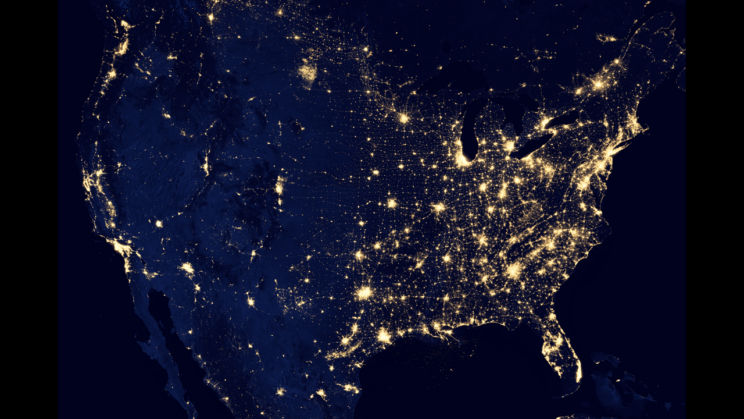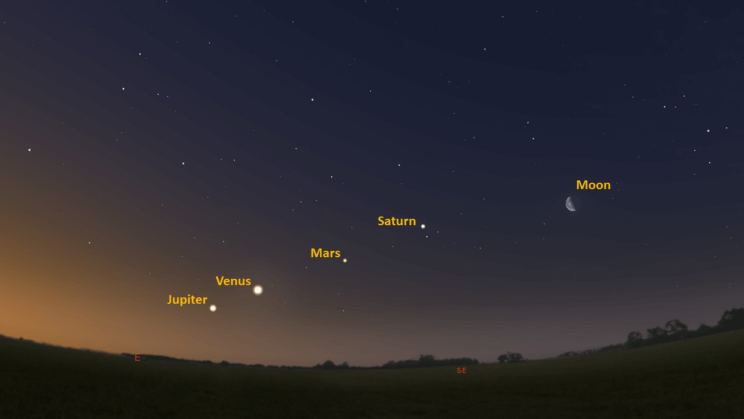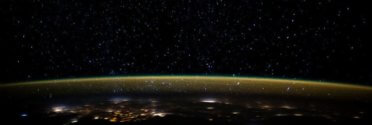This is the Saint Louis Science Center’s NIGHT SKY UPDATE for the week of Friday, April 22, 2022.
Information updated weekly or as needed.
Times given as local St. Louis time which is Central Daylight Time (CDT). For definitions of terminology used in the night sky update, click the highlighted text. If relying on times posted in Universal Time (UT), St. louis is -5 hours when CDT.
Public Telescope Viewings
With the changing recommendations from the CDC regarding COVID-19, conversations regarding the return of star parties at the Saint Louis Science Center have begun. We are close to bringing back our public telescope viewings, but a few details still need to be worked out. We will post future updates as we learn more about when we can bring back telescope viewings.
Observing Highlight of the Week

Night view of City across the US and parts of Mexico and Canada seen by SUOMI. Image Credit: NASA Earth Observatory/NOAA NGDC
Friday 22, 2022, marks the beginning of International Dark Sky Week. This annual observation is organized by the International Dark-Sky Association (IDA) which acts to help protect the night from light pollution. Light pollution affects all life on this planet, and it is uniquely human in origin.
Light pollution is defined by the IDA as “any adverse effect or impact attributable to artificial light at night.” The impact of light pollution reaches beyond limiting what we see in the night sky. Aside from ruining the night sky, light pollution has a wide-ranging impact on wildlife, human health, economies, and climate change.
There are several ways we can celebrate International Dark Sky Week. Start by checking to see if there are any local events. For those in the St. Louis area, I would check DarkSkyMissouri.org for local events. This is the website for the Missouri chapter of the International Dark-Sky Association. Those that live outside Missouri should visit https://www.darksky.org/ which is the website for IDA.
Additionally, IDA has posted several ways one can take action regarding light pollution. These can be found at https://idsw.darksky.org/, which is the website setup for International Dark Sky Week. One of the ideas you will find is called Globe at Night. This is an international citizen-science program that aims to bring awareness to light pollution. It does so by encouraging citizen-scientists to measure and submit observations of their night sky brightness. This is done by visiting the link for their current observing campaign. For us in St. Louis the current campaign can be found here. Following this link will take you to the observing campaign for April 22, – May 1, 2022, which uses the constellation Leo the Lion. The website will first teach you how to find Leo from your observing site and give you a little mythology for the constellation. Once you can find Leo, there is a link for magnitude charts that you use to determine the darkness of your observing site. Pick the one that best matches what you see. Once you have your magnitude chart selected, visit the report section of the Globe at Night website, and fill out the relevant information.
The Globe at Night program has effectively brought awareness to the growing problem of light pollution for the last 14 years. The data collected by the program helps document the increase of light pollution, the causes, and its impact. Their website along with IDA’s, has several resources for those wishing to learn more about light pollution.
Another program occurring during International Dark Sky Week is Lights Out Heartland. This program is the result of organizations in the American heartland collaborating to reduce light pollution during bird migrations. Migratory birds are but one example of how light pollution can impact an ecosystem. Surprising as it may seem, migratory birds have several ways to navigate during annual migrations. Among these is the ability to gain compass information from Sun position, star position and sensitivity to Earth’s magnetic field which are all impacted by light pollution. As these birds fly over cities with bright artificial lights, it can disorient the birds causing them to collide with buildings. Programs like Lights Out Heartland are important tools to keeping our ecosystems healthy and bringing awareness to the problems that stress them. If you would like to learn more about how birds are a key part of our ecosystem, check out this article from Audubon. The James S. McDonnell Planetarium and Saint Louis Science Center will take part in Lights Out Heartland by turning off its night lighting from April 22 to April 30, 2022.
Missouri is part of the Mississippi Flyway which runs the extant of the Americas from South America to North America. Flyways are flight paths used by many migratory birds as they travel between their breeding grounds and overwintering sites. There are 325 bird species that make use of the Mississippi Flyway each year. As International dark Sky Week aims to bring awareness to light pollution, an interesting way to connect to this effort is to try your hand at observing birds in your area that are making use of the Mississippi Flyway. I would recommend starting with birds in the Warbler group. Warblers are small perching birds that are also very vocal of which we have several species. If you would like to learn more about birds in Missouri visit
https://www.stlzoo.org/animals/abouttheanimals/birds
https://riverlands.audubon.org/
https://www.worldbirdsanctuary.org/
https://mdc.mo.gov/wildlife/birds
The Sun and Moon

The Moon as seen from the International Space Station, on July 31, 2011.
Credit: NASA
Sunrise is at 6:15 a.m. on Friday, April 22 and sunset is at 7:44 p.m. providing us with 13.5 hours of daylight. Even after sunset, the light from the Sun will dimly illuminate our sky for roughly 1 hour and 40 minutes. This period is called twilight, which ends around 9:22 p.m. this week. For those with a sundial, local noon occurs around 12:59 p.m. this week.
| 2022-04-22 | 6:15 a.m. | 7:44 p.m. |
|---|---|---|
| 2022-04-23 | 6:13 a.m. | 7:45 p.m. |
| 2022-04-24 | 6:12 a.m. | 7:46 p.m. |
| 2022-04-25 | 6:11 a.m. | 7:47 p.m. |
| 2022-04-26 | 6:09 a.m. | 7:48 p.m. |
| 2022-04-27 | 6:08 a.m. | 7:49 p.m. |
| 2022-04-28 | 6:07 a.m. | 7:50 p.m. |
| 2022-04-29 | 6:06 a.m. | 7:51 p.m. |
| 2022-04-30 | 6:05 a.m. | 7:52 p.m. |
Moon
Moonrise for Friday, April 22 occurs at 6:37 p.m. and moonset will occur at 6:28 a.m. on the following day. On Friday, April 22, the Moon will exhibit a waning gibbous phase with 59% of the lunar disk illuminated. Last quarter moon for April occurs on April 23, 2022, at 6:56 a.m. The second new moon of April occurs on April 30, 2022. A month with two new moons occurs roughly every 29 months.
International Space Station (ISS) Observing

Visible passes of ISS from St. Louis for the week of April 22 occur during morning hours. The best passes occur on the mornings of April 23, 26 and 27. Use the table below for information about these and other visible passes this week.
Catch ISS from St. Louis starting Friday, April 22
| Date | Starts | Max. altitude | Ends | |||||||
|---|---|---|---|---|---|---|---|---|---|---|
| Time | Alt. | Az. | Time | Alt. | Az. | Time | Alt. | Az. | ||
| 23 Apr | -3.3 | 05:41:15 | 10 | SW | 05:44:31 | 58 | SE | 05:47:47 | 10 | ENE |
| 24 Apr | -2.3 | 04:54:09 | 18 | S | 04:56:01 | 31 | SE | 04:59:00 | 10 | ENE |
| 25 Apr | -1.5 | 04:07:38 | 17 | SE | 04:07:38 | 17 | SE | 04:09:50 | 10 | E |
| 25 Apr | -3.2 | 05:40:50 | 10 | WSW | 05:44:03 | 46 | NW | 05:47:16 | 10 | NE |
| 26 Apr | -3.9 | 04:53:55 | 30 | SW | 04:55:24 | 82 | NW | 04:58:44 | 10 | NE |
| 27 Apr | -3.1 | 04:07:12 | 48 | ESE | 04:07:12 | 48 | ESE | 04:10:04 | 10 | ENE |
| 27 Apr | -1.9 | 05:41:06 | 10 | WNW | 05:43:43 | 21 | NNW | 05:46:21 | 10 | NNE |
| 28 Apr | -0.9 | 03:20:25 | 15 | E | 03:20:25 | 15 | E | 03:21:10 | 10 | ENE |
| 28 Apr | -2.5 | 04:53:18 | 20 | W | 04:54:56 | 31 | NNW | 04:57:57 | 10 | NE |
| 29 Apr | -3.1 | 04:06:26 | 49 | NNW | 04:06:26 | 49 | NNW | 04:09:26 | 10 | NE |
| 30 Apr | -1.3 | 03:19:30 | 22 | NE | 03:19:30 | 22 | NE | 03:20:49 | 10 | NE |
| 30 Apr | -1.4 | 04:52:23 | 10 | WNW | 04:54:36 | 16 | NNW | 04:56:49 | 10 | NNE |
Magnitude (Mag): The Measure of brightness for a celestial object. The lower the value is, the brighter the object will be.
Altitude (Alt): The angle of a celestial object measured upwards from the observer’s horizon.
Azimuth (Az): The direction of a celestial object, measured clockwise from an observer’s location with north being 0°, east being 90°, south being 180° and west being 270°.
For information about ISS flyovers and other visible satellites, visit www.heavens-above.com
Detailed information regarding all unmanned exploration of our universe, missions past, present, and planned, can be found at Jet Propulsion Laboratories:
The Visible Planets

Looking south at 5:30 a.m. April 23, 2022. Credit: Stellarium, EG
This week, four naked eye planets are visible. Venus, Mars, Jupiter and Saturn are seen in the east and southeast before sunrise.
Venus
Venus has started a morning apparition and will be seen in the southeast before sunrise. Venus rises at 4:33 a.m. and should be easy to spot in the southeast by 5:30 a.m. The current morning apparition lasts until the third week of October 2022. Venus reaches superior conjunction on October 22, 2022.
Mars
A new apparition for Mars has begun. Mars rises at 4:03 a.m. Start looking for Mars around 5:00a.m. as it clears trees and buildings. Mars will continue to climb out of the Sun’s glare as it heads towards opposition later this year on December 7, 2022.
Jupiter
Jupiter is beginning to climb out of the Sun’s glare about 30 minutes before sunrise. Those with a clear view of the east may catch a view of Jupiter around 5:45 a.m. Jupiter will become much easier to see by May 2022. Jupiter reaches opposition on September 26, 2022. As we approach this date, Jupiter will become visible earlier each night.
There will be a nice pairing of Jupiter, Venus and the Moon later this month on April 27, 2022. This will be followed be a close pairing of Venus and Jupiter on April 30 and May 1, 2022.
Saturn
Saturn rises at 3:28 a.m. Start looking for Saturn around 4:30 a.m. in the southeastern sky. Saturn will reach opposition on August 14, 2022. As we head to this date, Saturn will rise earlier each day.
James S. McDonnell Planetarium
Night Sky Update: April 22 – April 30, 2022







